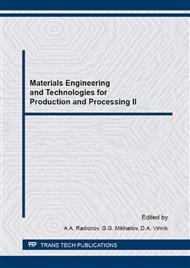[1]
G. Gottshtein, Physical Foundations of Materials Science, Springer-Verlag, Berlin Heidelberg, (2004).
Google Scholar
[2]
L.V. Tarasenko, S.A. Pakhomova, M.V. Unchikova, S.A. Gerasimov, Materials Science, INFRA-M Publ., Moscow, (2012).
Google Scholar
[3]
S.A. Pakhomova, N.M. Ryzhov. Changes in the Structure of Martensite of Iron-Nickel Alloys under the Action of Thermal Shotblast Treatment, Metal Science and Heat Treatment. 43 (2001) 438-439.
Google Scholar
[4]
S.A. Pakhomova. The Influence of Technological Heredity, Created by Termochemical Treatment, on the Plastic Deformation Hardening, 11 th Congress of the IFHT. 3 (1998) 61-67.
Google Scholar
[5]
N.M. Ryzhov, A.E. Smirnov. Control of Carbon Saturation of the Diffusion Layer in Vacuum Carburizing of Heat-Resistant Steels, Metal Science and Heat Treatment. 7 (2010) 340-344.
DOI: 10.1023/b:msat.0000048845.35526.09
Google Scholar
[6]
S.A. Pakhomova, A.S. Pomelnikova, Integrated hardening of the heavily loaded gear surfaces, Contemporary Innovation Technique of the Engineering Personnel Training for the Mining and Transport Industry. 1 (2014) 184-193.
Google Scholar
[7]
S.A. Pakhomova S.A. Improvement of Surrface Hardening Technology to Heatresistance Steel, Russian Journal of Heavy Machinery. 10 (2009) 35-38.
Google Scholar
[8]
M.Y. Semenov, R.S. Fakhurtdinov, M.M. Lashnev, Evaluation of the characteristics of hardening of heat-resistant steel subjected to combined thermochemical treatment, Metal Science and Heat Treatment. 55 (2013) 345-350.
DOI: 10.1007/s11041-013-9632-6
Google Scholar
[9]
N.M. Ryzhov, R.S. Fakhurtdinov, A.E. Smirnov, L.A. Fomina, Analysis of methods of carburizing of gears from heat-resistant steels, Metal Science and Heat Treatment. 52 (2010) 260-265.
DOI: 10.1007/s11041-010-9261-2
Google Scholar
[10]
S.A. Pakhomova, Efficiency of the plastic deformation hardening, Deformation and Fracture of Materials. 1 (2007) 17-20.
Google Scholar
[11]
N. M. Ryzhov, R. S. Fakhurtdinov, A. E. Smirnov, Cyclic strength of steel 16Kh3NVFBM-Sh (VKS-5) after vacuum carburizing, Metal Science and Heat Treatment, 52 (2010) 61-66.
DOI: 10.1007/s11041-010-9230-9
Google Scholar
[12]
S.A. Pakhomova. The Deformation Hardening of carburized steel, The 1-st International Conference «Deformation and Fracture of Materials». 1 (2006) 19.
Google Scholar
[13]
S.A. Pakhomova, Structure and contact fatigue strength of carburized steel after the deformation hardening, The 3-d International Conference «Deformation and Fracture of Materials and Nanomaterials» (DFMN2009). 3 (2009) 300-302.
Google Scholar


